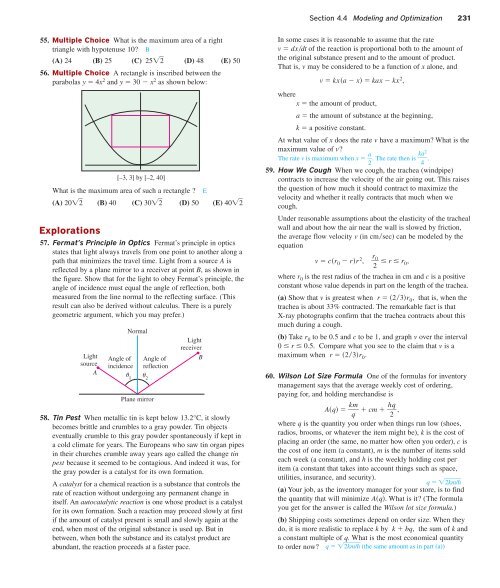5128_Ch04_pp186-260
Create successful ePaper yourself
Turn your PDF publications into a flip-book with our unique Google optimized e-Paper software.
Section 4.4 Modeling and Optimization 231<br />
55. Multiple Choice What is the maximum area of a right<br />
triangle with hypotenuse 10? B<br />
(A) 24 (B) 25 (C) 252 (D) 48 (E) 50<br />
56. Multiple Choice A rectangle is inscribed between the<br />
parabolas y 4x 2 and y 30 x 2 as shown below:<br />
What is the maximum area of such a rectangle ?<br />
(A) 202 (B) 40 (C) 302 (D) 50 (E) 402<br />
Explorations<br />
[–3, 3] by [–2, 40]<br />
57. Fermat’s Principle in Optics Fermat’s principle in optics<br />
states that light always travels from one point to another along a<br />
path that minimizes the travel time. Light from a source A is<br />
reflected by a plane mirror to a receiver at point B, as shown in<br />
the figure. Show that for the light to obey Fermat’s principle, the<br />
angle of incidence must equal the angle of reflection, both<br />
measured from the line normal to the reflecting surface. (This<br />
result can also be derived without calculus. There is a purely<br />
geometric argument, which you may prefer.)<br />
Light<br />
source<br />
A<br />
Angle of<br />
incidence<br />
1<br />
Normal<br />
Plane mirror<br />
Angle of<br />
reflection<br />
2<br />
Light<br />
receiver<br />
58. Tin Pest When metallic tin is kept below 13.2°C, it slowly<br />
becomes brittle and crumbles to a gray powder. Tin objects<br />
eventually crumble to this gray powder spontaneously if kept in<br />
a cold climate for years. The Europeans who saw tin organ pipes<br />
in their churches crumble away years ago called the change tin<br />
pest because it seemed to be contagious. And indeed it was, for<br />
the gray powder is a catalyst for its own formation.<br />
A catalyst for a chemical reaction is a substance that controls the<br />
rate of reaction without undergoing any permanent change in<br />
itself. An autocatalytic reaction is one whose product is a catalyst<br />
for its own formation. Such a reaction may proceed slowly at first<br />
if the amount of catalyst present is small and slowly again at the<br />
end, when most of the original substance is used up. But in<br />
between, when both the substance and its catalyst product are<br />
abundant, the reaction proceeds at a faster pace.<br />
B<br />
E<br />
In some cases it is reasonable to assume that the rate<br />
v dxdt of the reaction is proportional both to the amount of<br />
the original substance present and to the amount of product.<br />
That is, v may be considered to be a function of x alone, and<br />
v kxa x kax kx 2 ,<br />
where<br />
x the amount of product,<br />
a the amount of substance at the beginning,<br />
k a positive constant.<br />
At what value of x does the rate v have a maximum? What is the<br />
maximum value of v?<br />
The rate v is maximum when x a 2 . The rate then is k a<br />
.<br />
2<br />
4<br />
59. How We Cough When we cough, the trachea (windpipe)<br />
contracts to increase the velocity of the air going out. This raises<br />
the question of how much it should contract to maximize the<br />
velocity and whether it really contracts that much when we<br />
cough.<br />
Under reasonable assumptions about the elasticity of the tracheal<br />
wall and about how the air near the wall is slowed by friction,<br />
the average flow velocity v (in cmsec) can be modeled by the<br />
equation<br />
v cr 0 rr 2 , r 0<br />
r r<br />
2<br />
0 ,<br />
where r 0 is the rest radius of the trachea in cm and c is a positive<br />
constant whose value depends in part on the length of the trachea.<br />
(a) Show that v is greatest when r 23r 0 , that is, when the<br />
trachea is about 33% contracted. The remarkable fact is that<br />
X-ray photographs confirm that the trachea contracts about this<br />
much during a cough.<br />
(b) Take r 0 to be 0.5 and c to be 1, and graph v over the interval<br />
0 r 0.5. Compare what you see to the claim that v is a<br />
maximum when r 23r 0 .<br />
60. Wilson Lot Size Formula One of the formulas for inventory<br />
management says that the average weekly cost of ordering,<br />
paying for, and holding merchandise is<br />
Aq k m hq<br />
cm ,<br />
q 2<br />
where q is the quantity you order when things run low (shoes,<br />
radios, brooms, or whatever the item might be), k is the cost of<br />
placing an order (the same, no matter how often you order), c is<br />
the cost of one item (a constant), m is the number of items sold<br />
each week (a constant), and h is the weekly holding cost per<br />
item (a constant that takes into account things such as space,<br />
utilities, insurance, and security).<br />
q 2km/h <br />
(a) Your job, as the inventory manager for your store, is to find<br />
the quantity that will minimize Aq. What is it? (The formula<br />
you get for the answer is called the Wilson lot size formula.)<br />
(b) Shipping costs sometimes depend on order size. When they<br />
do, it is more realistic to replace k by k bq, the sum of k and<br />
a constant multiple of q. What is the most economical quantity<br />
to order now? q 2km/h (the same amount as in part (a))












